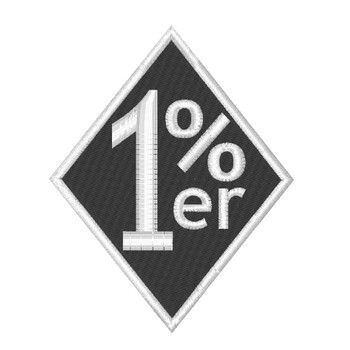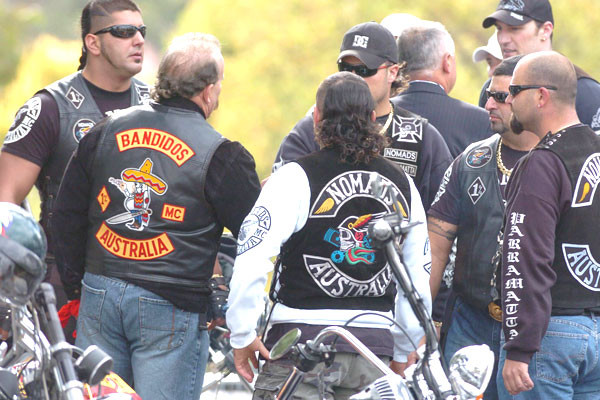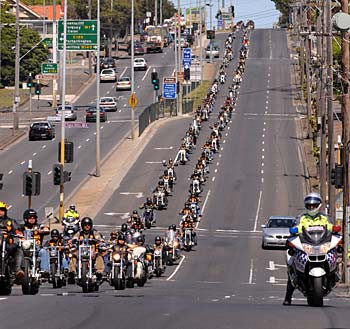The term 1er biker, often interchanged with one percenter biker or 1%er biker, is used to identify members of outlaw motorcycle clubs. These clubs, such as the Hells Angels Motorcycle Club, Bandidos Motorcycle Club, Pagans Motorcycle Club, and Outlaws Motorcycle Club, are distinguished from the 99% of motorcycle riders who are law-abiding citizens. The 1er biker label signifies a deliberate separation from mainstream society and adherence to a different set of rules and values.
 one percenter patchClose-up view of a 1%er patch, a symbol worn by outlaw motorcycle club members to denote their one percenter status.
one percenter patchClose-up view of a 1%er patch, a symbol worn by outlaw motorcycle club members to denote their one percenter status.
The Origin and History of the 1er Biker Expression
The phrase “1er biker” and its variations, such as “1%er” or “one percenter,” originated from a statement attributed to the American Motorcycle Association (AMA) following the infamous 1947 Hollister Riot in Hollister, California. In response to the media frenzy and public concern generated by the riot, the AMA reportedly declared that 99% of motorcycle riders are law-abiding citizens.
This statement, intended to reassure the public, had an unintended consequence. Certain motorcycle clubs at the time embraced the remaining 1%, proudly proclaiming themselves as the “one percenters.” They adopted this label as a badge of honor, signifying their rejection of societal norms and their embrace of a more rebellious and independent lifestyle. This marked the birth of the 1er biker identity and the formalization of the outlaw motorcycle club ethos.
The Rise of Outlaw Motorcycle Clubs and the 1er Biker Culture
The emergence of outlaw motorcycle clubs and the associated 1er biker culture gained significant traction in the post-World War II era, specifically in the late 1940s. This period witnessed a confluence of factors that contributed to the growth of these clubs.
Firstly, the end of World War II resulted in a large influx of veterans returning home. Many of these ex-servicemen struggled to readjust to civilian life, finding the routine and lack of adrenaline in stark contrast to their wartime experiences. They missed the camaraderie, excitement, and sense of purpose that military service had provided.
Secondly, the post-war period saw a surplus of Harley Davidson motorcycles. These bikes, originally manufactured for military use, became readily available and affordable to the returning veterans.
Combining these two elements – a desire for excitement and brotherhood among veterans and the availability of motorcycles – created a fertile ground for the growth of outlaw motorcycle clubs. For many ex-servicemen, joining a motorcycle club and embracing the 1er biker lifestyle offered a way to recapture the thrill and camaraderie they had experienced during the war, while forging a new identity outside of mainstream society.
 multiple one percenter clubs meetingA gathering of members from various prominent 1%er motorcycle clubs, showcasing the inter-club dynamics and shared identity within the outlaw biker community.
multiple one percenter clubs meetingA gathering of members from various prominent 1%er motorcycle clubs, showcasing the inter-club dynamics and shared identity within the outlaw biker community.
Prominent 1er Motorcycle Clubs Around the World
1er biker clubs are not confined to a single geographical location; they have established a global presence. Clubs like the Hells Angels Motorcycle Club and Outlaws Motorcycle Club, among others, operate through a chapter-based structure. This means they are organized into smaller local units, known as “chapters” or “charters,” spread across numerous cities and even countries.
These outlaw motorcycle clubs, while operating outside the norms of mainstream society, are typically legal entities. They often generate revenue through the sale of supporter gear and merchandise, further solidifying their brand and identity within the 1er biker subculture.
Some of the most globally recognized 1er biker clubs include:
- Hells Angels Motorcycle Club
- Outlaws Motorcycle Club
- Bandidos Motorcycle Club
- Pagans Motorcycle Club
- Mongols Motorcycle Club
The Significance of the 1% Patch for 1er Bikers
A defining symbol of the 1er biker identity is the “1%” or “1%er” patch. This patch is proudly worn on the vests or jackets of members who identify with the outlaw motorcycle club ethos. It serves as a visual declaration of their status as a one percenter, instantly recognizable to both fellow club members and the wider public. The 1% patch is more than just an emblem; it represents a commitment to the values and lifestyle associated with being a 1er biker.
Media Portrayal and the Reality of 1er Bikers and Crime
Media coverage of 1er biker clubs often focuses on criminal activities allegedly linked to these groups. While it is undeniable that some individuals within these clubs have engaged in criminal behavior, the media’s portrayal is often skewed, disproportionately emphasizing the negative aspects to sensationalize stories and potentially incite public fear.
It is crucial to recognize that while criminal activities may occur, they do not represent the entirety of the 1er biker world. The vast majority of interactions and activities within these clubs are internal, relating to club business, social events, and shared motorcycle culture. The common adage, “live and let live,” often holds true; as long as individuals outside the 1er biker community do not interfere with club affairs, they are unlikely to encounter any issues.
 one percenter bikers and policeA photograph depicting 1%er bikers in a public space with a police presence, illustrating the complex relationship and scrutiny faced by outlaw motorcycle clubs.
one percenter bikers and policeA photograph depicting 1%er bikers in a public space with a police presence, illustrating the complex relationship and scrutiny faced by outlaw motorcycle clubs.
Government Scrutiny and the Legal Landscape for 1er Bikers
Government agencies in the United States and internationally have taken a strong stance against outlaw motorcycle clubs, particularly the “Big Four” – the Hells Angels Motorcycle Club, Bandidos Motorcycle Club, Outlaws Motorcycle Club, and Pagans Motorcycle Club. These clubs have been targeted under the RICO (Racketeer Influenced and Corrupt Organizations Act) statute, legislation initially designed to combat organized crime syndicates like the Mafia.
Beyond the United States, other governments are also implementing measures to counter outlaw motorcycle clubs. These efforts include enacting laws that restrict the association and communication between club members, reflecting a global trend of increased scrutiny and legal pressure on 1er biker organizations.
Understanding the term “1er biker” requires looking beyond sensationalized media portrayals and recognizing the historical, social, and cultural context that shaped the outlaw motorcycle club phenomenon. By exploring their origins, values, and the complexities of their relationship with both mainstream society and law enforcement, we gain a more nuanced perspective on this often misunderstood subculture.

